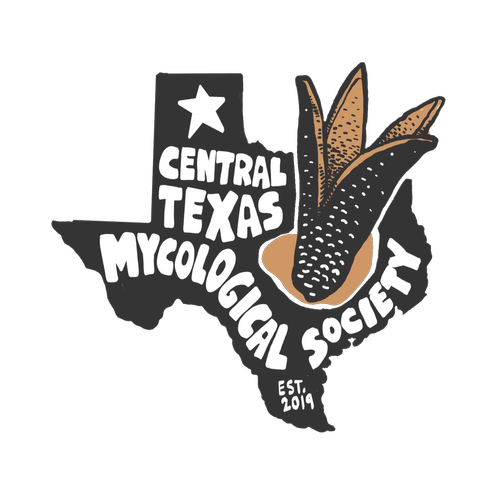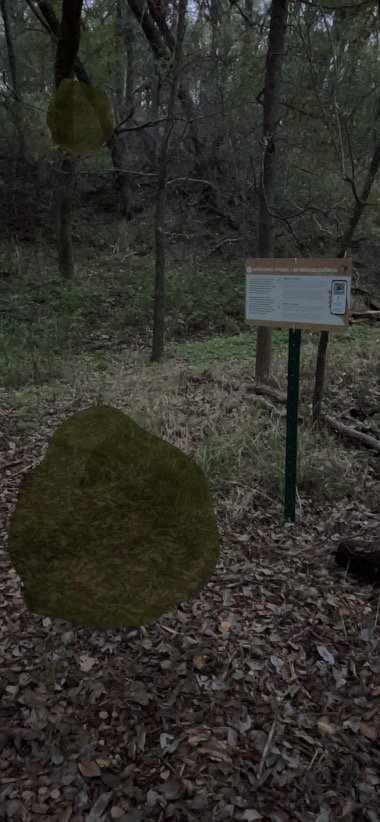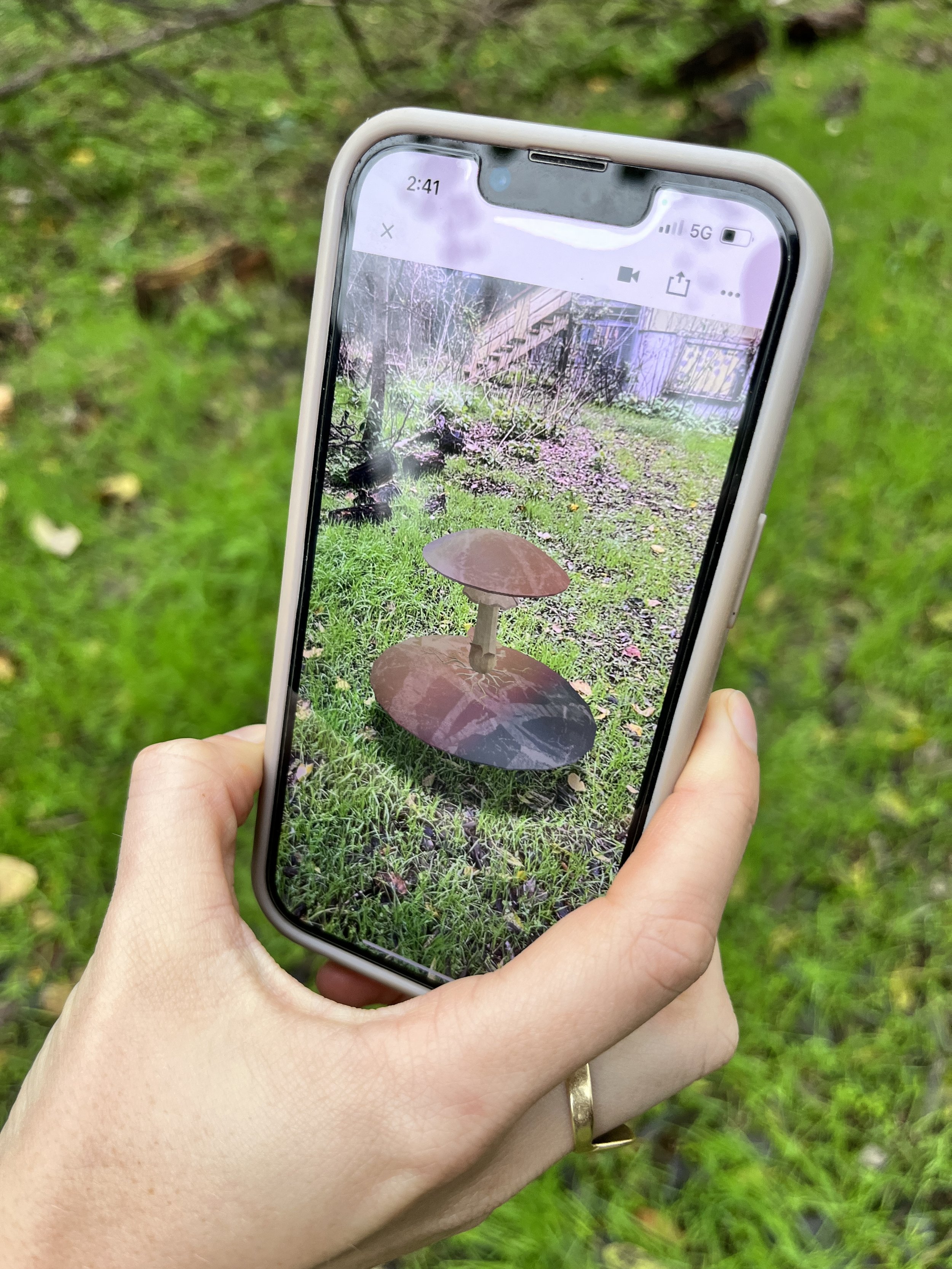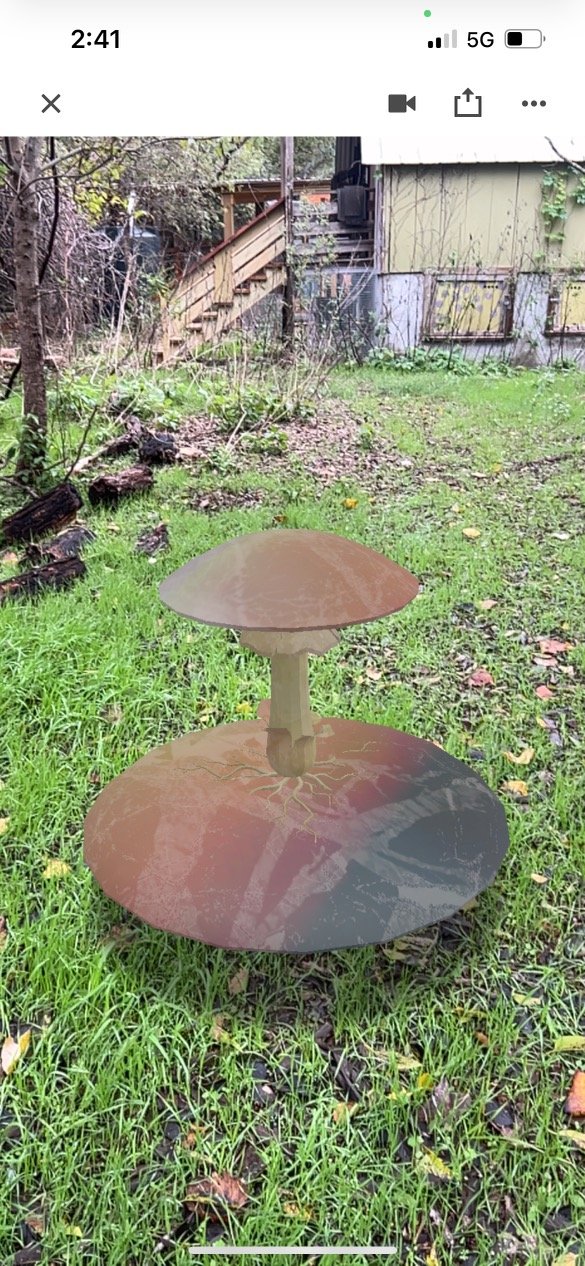Decompose / Descomponer
A SELF guided art walk exploring the mushroom life cycle and history of Circle Acres Nature Preserve
Visit Circle Acres anytime to view a new public artwork, “Decompose / Descompone”. Developed by artist Sara Dotterer, the artwork is a self-guided walk and mediation that aims to highlight the history and ecology of Circle Acres as well as the interactions between soil, tree, and fungal networks. While walking, you will explore the life cycle of fungi and the history of Circle Acres Nature Preserve through observations, movement-based actions, as well as augmented reality on your own phone.
The walk will include an opportunity to engage with this new artwork individually, as well as a guided tree and fungi walk facilitated by CTMS’s Chris Kennedy, and Ann Armstrong from the Odditree Society. Come experience the natural world in new ways through site-specific art! Open to all!
About
Decompose/Descomponer is a self-guided art walk and mediation that aims to highlight the history and ecology of Circle Acres as well as the interactions between soil, tree, and fungal networks. While walking, you will explore the lifecycle of mushrooms, the history of this preserve, and your relationship to both. You will encounter five signs along the trail. Each sign invites you to
Observe and meditate,
Interact through guided prompts, and
Explore the site in new ways through augmented reality on your own phone (just scan the QR Code)!
Use the map below to navigate the trail. The entire loop is under a mile. Note: Please stay on the trail at all times.
The Site
Decompose/Descomponer takes place at Circle Acres Nature Preserve! This site is cared for by Ecology Action of Texas, an Austin-based organization created in 1969 with a goal to protect, reclaim, and connect communities to neglected or damaged remnants of the urban wilderness. The Preserve is 10 acres of wetland, forest and grassland home to over 150 bird species as well as fungi, insects, with deer, turtles and other wildlife. But, it wasn’t always as biodiverse and lush as it is now! Circle Acres has had a long history of multiple uses: a dairy farm, quarry, landfill and illegal dumping site. Thanks to Ecology Action, it is now a site for exploration, observation and education!
Location: Circle Acres Nature Preserve and Roy Guerrero Park, 400 Grove Blvd, Austin, TX 78741. Park in the lot located off Grove Blvd. (Map)
Walking Tour Sites
1. Spreading Spores
Mushrooms are the “fruit” of fungus and emerge from a “root system” called mycelium. When it’s time for mushrooms to reproduce, they spread their spores (which are like seeds!). Scan the QR code below to bring spores to life with your phone.
Reflect: Just as fungi spread spores to renew and transform, reflect on the history of this site. Consider the patterns of disturbance and the current biodiversity of forest, wetland, and grassland environments. As you walk, what do you see that offers evidence of past destruction, but also new life?
Engage: Bend down, pick up a seed on the forest floor and find a new home for it so it may expand its presence in the preserve. What seeds of awareness and knowledge can you spread upon leaving the park?
2. Building a Hyphal Network
After fungi release their spores, they slowly grow into mycelium, the “roots” of mushrooms. Mycelium spreads across the forest floor, often below your feet. Some mycorrhizal fungus species partner with plants and trees. Scan the QR code below to bring spores to life with your phone.
Reflect: Just as fungi spread spores to renew and transform, reflect on the history of this site. Consider the patterns of disturbance and the current biodiversity of forest, wetland, and grassland environments. As you walk, what do you see that offers evidence of past destruction, but also new life?
Engage: Bend down, pick up a seed on the forest floor and find a new home for it so it may expand its presence in the preserve. What seeds of awareness and knowledge can you spread upon leaving the park?
3. Fruiting body
When a fungi is ready to produce a fruiting body, it will begin to grow upwards, out of the ground or from a decaying log, where you can see it.
Reflect: As you take in the blossoming flora and fauna (look out for deer!) around you, reflect on the transformative journey that this site has experienced from a landfill to the vibrant nature preserve “fruiting” before you.
Engage: Just like a blossoming mushroom, emerge from the soil by getting to an elevated viewpoint. Climb on top of a rock nearby to see a new perspective. Envision the growth yet to come, appreciating the journey that brought this land to its current state of flourishing. In your own life, what “fruit” is yet to appear?
4. DECOMPOSITION
Once a mushroom has fruited, it only lasts a few days or weeks depending on its species. It will then begin to decay and merge with the soil once again.
Engage: Look down at the ground, and acknowledge the remnants of the past that are a part of the soil's history. Move back towards the ground and find a comfortable sitting position. Slow your breath, close your eyes if you feel comfortable and let yourself melt into the soil. Pretend you are decaying and leave behind your trace.
Reflect: Consider how these remnants, much like the decay in a forest, play a role in a cycle of regeneration. What is “decaying” in your life that might give life to new ideas, new plans, new people?
5. Regeneration
After a cycle of decay, mushrooms begin again, breaking down only to be regrown by the spores they have spread. As you observe resilient plants reclaiming their place at Circle Acres, connect this visible regeneration to the historical efforts of stewardship and planning.
Engage: Count on your hands how many different species you observed. Take time to recognize the resilience of nature and ongoing process of healing here. Use the QR code to upload a species you see around you to the iNaturalist Project entitled “Circle Acres Biodiversity.”
Reflect: Over time, big changes are possible for mushrooms, for land, and for you! What in your own life is currently being regenerated or renewed? How might you approach your own renewal as you would land stewardship– slowly, consistently and thoughtfully?
Aknowledgements
Thanks to the City of Austin Urban Forestry Grant program for their support.
Artist: Sara Dotterer
(b. 1995, Richmond, Virginia) Sara is an interdisciplinary artist and dancer researching eco-interoception or the deep connection between the health of her body and the earth’s. Knowledge of interoception, an awareness of what’s going on inside of the body, has allowed her to see her art's capacity for self-healing and neurogenesis (the creation of more interconnectivity within the brain). As she documents natural processes in the more-than-human world (trees, plants, slime molds, fungi), she uses that documentation to imagine her internal world – the cycles of decay and growth – always fluctuating. She works across media experimenting with the way that concepts and ideas develop as her means of making shifts across printmaking, video, foraging, inkmaking, sculpture, virtual reality, fiber and biomaterials. Sara received her B.A. in Studio Art and Anthropology at Washington and Lee University. She is now living in Austin, Texas after receiving her MFA in Interdisciplinary Art from Southern Methodist University.
Curator: Chris Kennedy, Central Texas Mycological Society
Christopher Kennedy is the associate director at the Urban Systems Lab, The New School and lecturer in the Parsons School of Design. Kennedy’s research focuses on the social-ecological benefits of urban plant communities, and the role of civic engagement in developing new approaches to environmental stewardship and nature-based resilience.
As artist-designer Kennedy creates site-specific projects that examine conventional notions of “Nature,” interspecies agency, and biocultural collaboration. Drawing from a background in environmental engineering, Kennedy re-imagines field science techniques and new forms of storytelling to develop embodied research, installations, sculptures, and publications that recontextualize social-ecological systems. Over the past several years, Kennedy has been increasingly interested in how urban centers are adapting to global climate shifts including rising temperatures, toxic soils, mega-droughts, flooding events, and unprecedented development. His recent projects explore the social-ecological role of ruderal ecologies (eg. vacant lots, highway medians, post-industrial sites and transient green spaces), and the possibility of multispecies kinship for reinvigorating relationships with urban ecological commons.
Kennedy has worked collaboratively on projects shown at the Philadelphia Academy of Fine Arts, the North Carolina Museum of Art, the Southeastern Center for Contemporary Art, the Levine Museum of the New South, Hudson Valley Center for Contemporary Art, the Ackland Art Museum and the Queens Museum. He holds a BS in Environmental Engineering from RPI, a MA in Environmental Conservation Education from NYU and a PhD in Cultural Studies from the University of North Carolina.
Partner: Eric Paulus, Ecology Action
Eric Paulus is the Operations Director at Ecology Action’s Circle Acres Nature Preserve. Before joining Ecology Action, Eric owned a small farm and plant nursery called Regeneration Eco-Farm. Regeneration served as a model urban farm for sustainable production and ecological stewardship. He gained valuable horticultural experience working at various farms, plant nurseries and landscaping companies. He has a BA from the University of Texas at Austin in Geography and History. He has spent time in southern India working on a reforestation project, co-managed a community garden and arboretum, and taught workshops on vermicomposting, Integrated Pest Management and enhancing soil health by increasing organic matter. Aside from stints in Italy, India and Massachusetts, Eric has lived in Austin since 2000. He has a young son and is interested in the soil microbiome, biodiversity and native plants. As a former participant of the Rhizome Collective, Eric took part in the original clean up of Circle Acres in 2004-06 and has seen first-hand how far the site has come from its days as a toxic brownfield.













